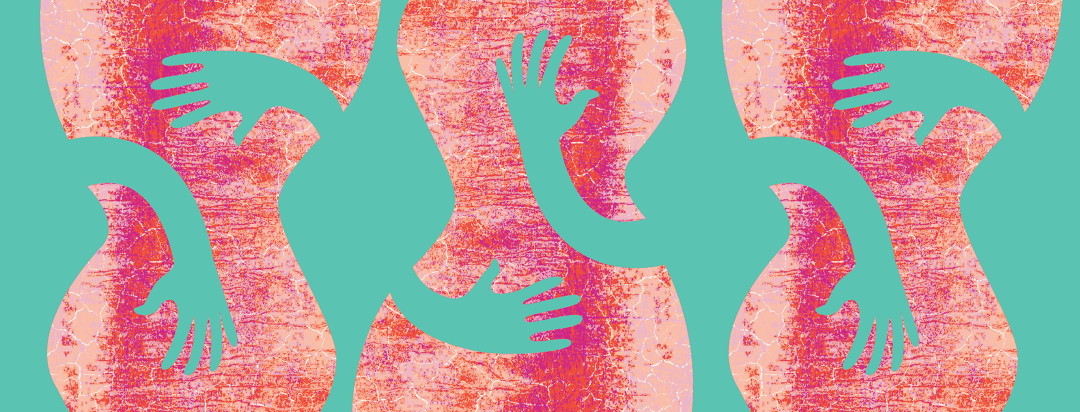Period Pain
Reviewed by: HU Medical Review Board | Last reviewed: June 2018 | Last updated: June 2024
Experiencing pain, specifically abdominal or pelvic pain, during your period is not uncommon. Many people refer to these as period cramps, and the pain can be described as a pressure-like sensation, cramping, or aching pain. This pain may range from mild to severe, and may affect the hips, inner thighs, or lower back, in addition to the lower abdomen or pelvis. This pain during menstruation is also called dysmenorrhea, and it is thought to affect over 50% of women who experience menstruation. Dysmenorrhea can affect women of any age during her reproductive years, from menarche (age of their first period) to menopause.1,2
Primary Dysmenorrhea
Period pain that occurs regularly and is not associated with another underlying condition is called primary dysmenorrhea. A woman may experience primary dysmenorrhea as early as one to two days before her period even begins. Primary dysmenorrhea may vary in severity and duration; however, it typically lasts for 12 to 72 hours. A woman may not always experience primary dysmenorrhea, and for some, the experience lessens over time. When a woman is experiencing primary dysmenorrhea, she may also experience fatigue, diarrhea, nausea, or vomiting.1-3
Unlike primary dysmenorrhea, secondary dysmenorrhea is a result of another underlying condition. Examples of conditions that can lead to secondary dysmenorrhea include endometriosis, uterine fibroids, infections, and pelvic inflammatory disease, among other conditions. Although secondary dysmenorrhea is most commonly related to another condition within the female reproductive tract, it may also be the result of conditions elsewhere in the body, especially intestinal-related conditions. In comparison to primary dysmenorrhea, period pain caused by secondary dysmenorrhea may have an earlier onset during the menstrual cycle and may be longer in duration.1-3
Causes of period pain
Period cramping that is not the result of another underlying condition is caused by muscle contractions that are too strong. When the uterus is shedding its lining during a woman's period, it also experiences muscle contractions. If these contractions are aggressive enough, they can cut off the oxygen supply to the uterine muscles by pushing against blood vessels in the area. If these muscles experience a brief lack of oxygen, pain will result. These muscle contractions are triggered by a hormone-like substance in the body called prostaglandin. The level of prostaglandin rises in the body right before a woman experiences menstruation and starts shedding her uterine lining. Once menstruation is underway, levels of prostaglandin decrease, which is why pain often tapers off after the first one to three days of the period. This pain mechanism is most associated with primary dysmenorrhea.1-3
This same process may play a role in secondary dysmenorrhea, however, this type of pain is mainly dictated by the underlying condition causing it. In the case of endometriosis, it is thought that this pain is a result of endometrial lesions elsewhere in the pelvis growing and breaking down where they shouldn't be. This process, along with the trapped blood and tissue it creates, may affect period pain. Additionally, endometrial lesions may affect the inflammatory and cell growth processes of the area surrounding them. These changes in inflammation and cell composition may affect pain levels during a woman's period. Finally, some theories suggest that endometriosis lesions may grow and irritate or infiltrate nerves within the pelvis. If these nerves are negatively impacted by endometriosis lesions, severe secondary dysmenorrhea may occur.4
Should your pain be evaluated?
If you are experiencing severe pain during your menstrual cycle that lasts for several days each month, consult your healthcare provider. Since period pain can be related to many different conditions, your doctor or ob-gyn provider may need to do some investigation to determine whether your pain is primary or secondary dysmenorrhea. Some common diagnostic tests and procedures a woman with period pain may go through are pelvic exams, examination of vaginal fluid, imaging exams such as ultrasound, or laparoscopy, which is a minimally invasive surgical procedure that allows your doctor to fully examine the inside of your pelvis. If your doctor believes that you have secondary dysmenorrhea, they may pursue further specific diagnostic exams to investigate whatever condition is causing the pain, and identify treatment options that may be beneficial for you.2,5
Treatment & Medication Options
Period pain may be treated in a variety of ways, depending on if it's primary or secondary dysmenorrhea, as well as how severe it is. Common treatment options for period pain include:
- Over-the-counter pain and anti-inflammatory medications such as acetaminophen, ibuprofen, naproxen, or aspirin
- Prescription anti-inflammatory medications
- Birth control pills or other hormonal contraceptive medications
- Surgery (In rare cases where an underlying condition that would benefit from surgery is causing the period pain)1,2,5
Although some of these treatment options may be available over-the-counter, it is still important to consult your healthcare provider before starting or stopping any new medication.
Alternative Management Options
In addition to the options outlined above, there are several potential lifestyle changes or alternative treatment options that may help a woman manage her period pain. Some of these include:
- Exercising regularly
- Avoiding large amounts of caffeine
- Using heat to soothe pain (such as a hot water bottle, heating pad, hot bath or hot shower)
- Quitting or avoiding smoking
- Cutting back or eliminating alcohol
- Getting adequate sleep
- Practicing yoga
- Acupuncture1-3,5
